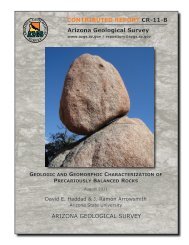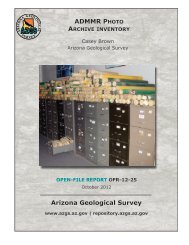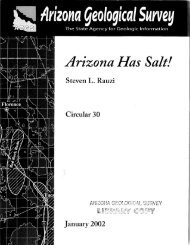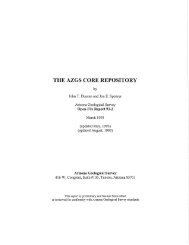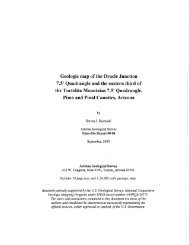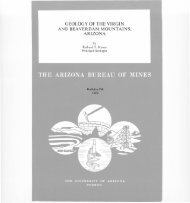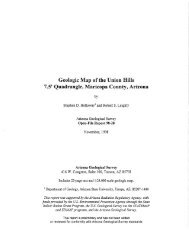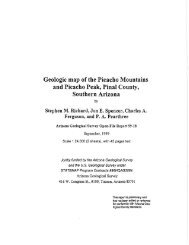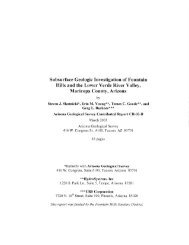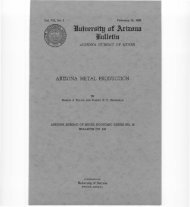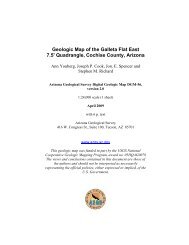ARIZONA MINING PERMITTING GUIDE - AZGS Document Repository
ARIZONA MINING PERMITTING GUIDE - AZGS Document Repository
ARIZONA MINING PERMITTING GUIDE - AZGS Document Repository
You also want an ePaper? Increase the reach of your titles
YUMPU automatically turns print PDFs into web optimized ePapers that Google loves.
Arizona Mining Permitting Guide<br />
Overview of Major Federal Environmental Laws - Continued<br />
address certain discharges incidental to the normal operations of a recreation vessel and was amended<br />
by Pub. L. 107-303 (11/27/02) to authorize the Administrator of the EPA to carry out projects and<br />
conduct research for remediation of sediment contamination in areas of concern in the Great Lakes,<br />
and for other purposes.<br />
Under Section 208 of the Act each state must identify the areas within the state that have substantial<br />
water quality problems. Areas identified as having such problems are subject to area-wide waste<br />
treatment plans. These plans provide for the treatment and control of all point and non-point pollution<br />
sources. Section 208 has significance for mining operations because no permit under Section 402<br />
(National Pollutant Discharge Elimination System) can be issued that conflicts with an area-wide<br />
waste treatment plan. Please refer to the entry titled “208 Consistency Review” in this handbook for<br />
more information.<br />
A permit is required for any discharge of pollutants subject to the Act. This requirement establishes<br />
the National Pollutant Discharge Elimination System (NPDES). NPDES permits are required for all<br />
existing and new sources of pollution governed by the Act. An EIS is not required for existing<br />
sources, but a full NEPA analysis is required for new sources. Some states have the authority to<br />
administer this program. This is the case is in Arizona where the Arizona Department of<br />
Environmental Quality have responsibility for AZPDES permits. Refer to the entry titled<br />
“Stormwater Discharges from Industrial Activities” and “Point Sources Discharge to Surface Waters”<br />
in this handbook for more information.<br />
Discharges of harmful quantities of hazardous substances or oil in harmful quantities are prohibited<br />
by Section 311 of the Act. Hazardous quantities for hazardous substances are specified in 40 C.F.R.<br />
117. A hazardous quantity of oil is an amount that “causes a film or sheen upon or discoloration of<br />
the surface of the water or adjoining shorelines or causes a sludge or emulsion to be deposited<br />
beneath the surface of the water or upon adjoining shorelines.” A spill prevention control and<br />
countermeasures (SPCC) plan is required for facilities with buried oil-storage tanks greater than<br />
42,000 gallons or surface tanks larger than 1320 gallons.<br />
Section 404 of this Act regulates the discharge of dredged or fill material into waters of the U.S.<br />
This Act authorizes the U.S. Army Corps of Engineers to issue permits for the discharge of dredged<br />
or fill materials into waters of the U.S. The definition given to waters of the U.S. is so broad that any<br />
operations conducted in any dry or flowing gully, wash, arroyo, creek, stream, river or lake or<br />
wetland should be presumed to be covered in the definition. Always consult with the Corp of<br />
Engineers before conducting operations in such areas. A NEPA analysis is required for the issuance<br />
of new individual 404 permits. Refer to the entry titled “Section 404 Permit (Dredge and Fill)” in this<br />
handbook for more information.<br />
Violations causing a “knowing endangerment of human life” can be punished with a fine of up to<br />
$250,000 and/or a 15-year sentence.<br />
10



